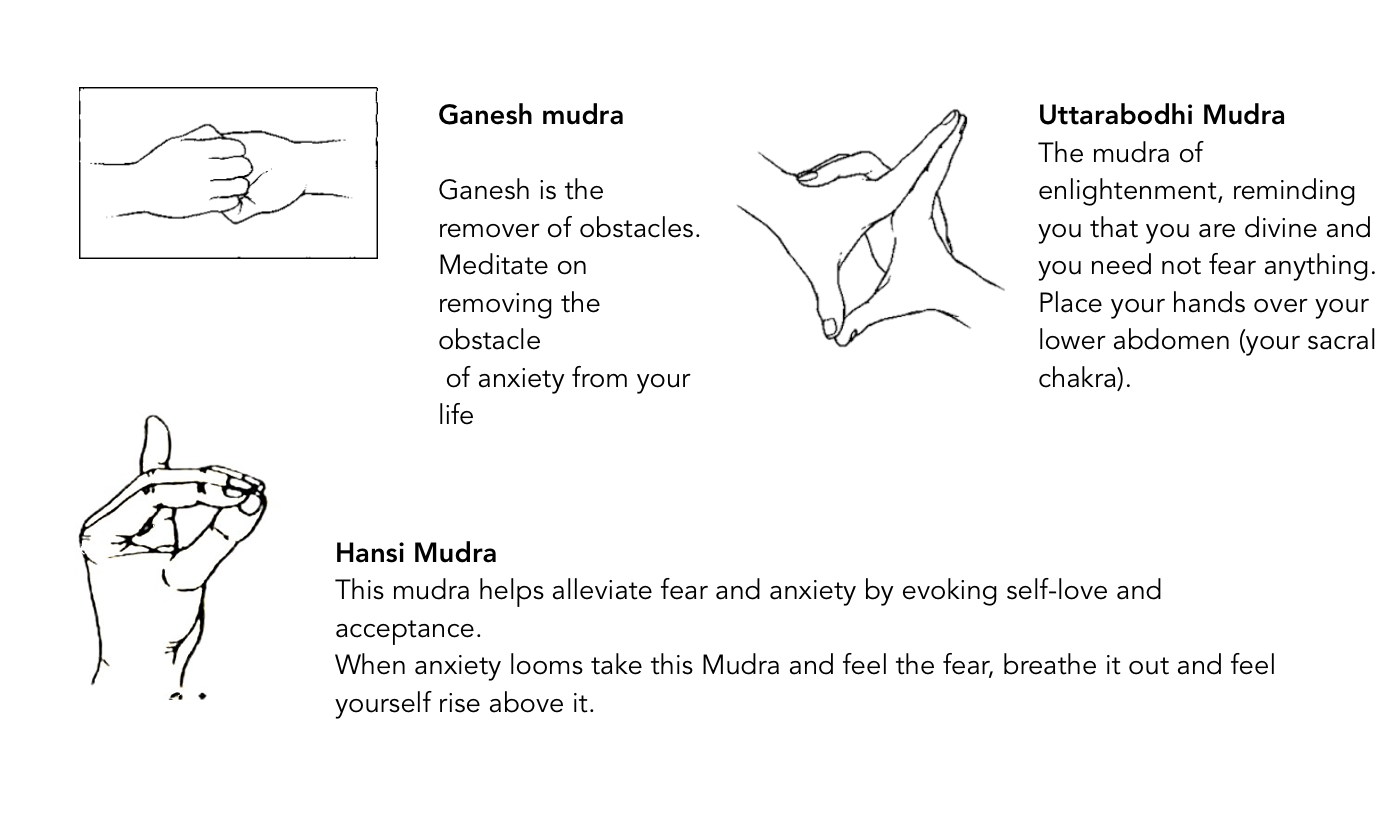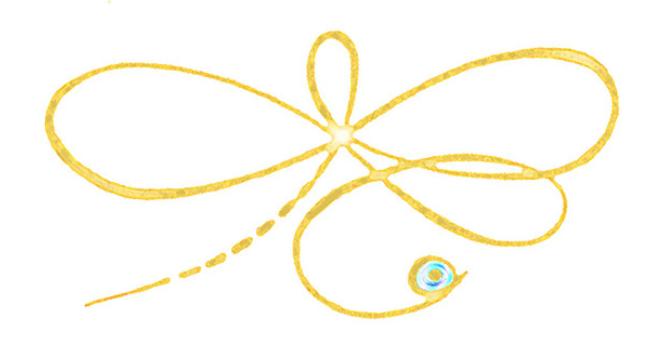Yoga for anxiety
In the previous post, I’ve briefly discussed some yogic philosophy that can help cope with anxiety: the notion of not being consumed by thoughts and sensations and knowing that your individual self is always part of the great divine universe (in a nutshell!).
If you can manage it during an episode of anxiety, then hatha yoga – the physical “effort” aspect of yoga practice is wonderful for helping to “still the fluctuations of the mind” or “chitti vritta nirodhaha” in sanskrit. This is why great sages such as Patanjali developed the physical aspect of yoga so comprehensively. The practice of combining the breath with healthful physical postures engages with the parasympathetic nervous system known as the “rest and digest” mechanism – the opposite of the sympathetic system which triggers the “fight or flight” response.
Certain poses are good for anxiety as they take the pressure off of the heart and lungs and unblock areas where anxiety gets trapped i.e. the hips often hold tension from unused adrenaline stored here in primordial preparation to run from danger, or stand to fight attackers. The shoulders, neck and jaw are especially tense areas for those with anxious tendencies.
Pranayama or “Breath Control”
Ujjayi breathing is an effective stress-relieving breathing technique. It is often known as the “ocean breath” as it can become like a soft sea sound. You breath in and out through the nose but the out breath is slowed down by slightly compressing the throat as if in a snore. You can do this on its own or combine the breath with the poses and witness your bodymind calm.
Anuloma Viloma, or ‘alternate nostril breathing’ helps to slow the breath which can be quickened when in a state of anxiety, panic or stress. Chandra (moon) Anuloma Viloma means breathing through the left nostril which is supposed to calm the mind.
Extending the out breath is a good practice to quell anxiety as we often take in too much oxygen when we are worried. Elongating the out breath helps oxygen leave the body. Remember this must be done very slowly followed by a gentle deep in breath into the belly visualising the chest expanding outwards rather than upwards.
Asanas or “Postures”
Moon salutations (chandra namaskar) is a sequence of postures that can burn off that excess, unnecessary adrenaline and help you focus and breathe in a controlled way without creating as much heat within the body as sun salutations (surya namaskar) can. “Cooling” is useful as stress and anxiety are hot emotions and cause friction within the body. Makes sense right?

Moon Salutation sequence with breathing instructions
Then try poses that get your hips above your heart

Surrender into Child’s pose

“Cat-cows” are a lovely way to connect with the breath, release stress from the hips, shoulders and even belly and pelvic floor.

Try some “Restorative” versions of poses for complete relaxation and passive tension release using pillows and props.

Simply sit in a position to open your hips and straighten your spine

Or lie down and relax the entire body in Savasana – “The Corpse Pose”. Let go of your attachments to your feelings and just be gently aware of your present state, focusing on your breath and releasing muscle tension by breathing it out.

Other techniques like Yoga Nidra or “psychic sleep” is very good at dealing with anxiety. You can attend a class or be led through it by a private yoga teacher who will guide you through relaxing your body and meditating on positivity. You can do a simple version by scanning the body and relaxing each body part individually.
Mudras (gestures/seals)
These are shapes made mostly with the hands, although other parts of the body are sometimes used, as a way to seal energy, and keep focused without having to analyse and re-convince yourself of calm and safety. Just make the gesture and your body will remember what your mind has learnt without having to explain it all over again right now. With anxiety sometimes the analysis of our feelings makes things worse, so we just need a short-cut to get to what we have worked out. A symbol of peace.
Here are a couple of examples to try:

If you are suffering from long-term anxiety issues then treat yourself to a private yoga session where you can learn poses that will be right for you. In my private yoga sessions I give the person the opportunity to discuss why they are anxious and work on their personal anxiety through their individual body with specially tailored asana (posture) practice and meditation. Or, you may want to keep it simple and just learn to let go into some comfy restful positions that feel good for you.

Superb article Flo! Great toolbox of simple but powerful exercises. Kundalini also offers some treasures which can have immediate impact and reduce symptoms significantly. But in the end it’s all about the same and we can choose what works best for us..as you said. The message is that there are millions of exercises out there and there is no need to give up hope before giving it a try. There s one for everyone:)
Thanks for your comment Leon! And for taking the time to read through. I would love to learn more about Kundalini and it’s powerful kriyas – a practice I’m just beginning to endeavour upon but need to get to some more classes 🙂 Of course you are right, yoga has so many techniques and technology to offer us on our journeys to understand what the nirvana is going on! Great to share. Xx
Thankyou Flo
Excellent article. Loved the illustrations. This will be a great help to so many sufferers.?️
Thank you Flo – just printed it all out and will add to my regime – so well planned out
I have anxiety as well, thanks for sharing!
Sorry to hear you have anxiety too, but I’m glad that we can all share our experiences and reach out to each other 🙂 Thank you for your comment and connection! Big love X
The Yoga Practice for Anxiety article is one of the best I have ever read!
I found a way to lose weight with yoga, maybe you try it too: https://bit.ly/YogaBurn108
You are doing a great job with https://spacetoflo.com site.
🙂 Congrat!
Thank you for your comment! I hope it helps in some way. Check out my website http://www.spacetoflo.com for more yogic offerings – I’m on the gut health tip these days 🙂
As I mentioned earlier, if you have a question about the writer’s post, ask that question. Chances are, if you’re confused, someone else will be, as well. Most blog authors will welcome your questions, and the opportunity to clarify their messages.
Make sure you’re polite, and that your intention is to understand better, not to point out faults or argue. (That said, some bloggers love to argue, so you’ll need to read the blog and other comments to get a feel for each site and what is acceptable.)
If you have a unique perspective to offer, a story to further illustrate the blogger’s point, or a point to add to what is already being said,
then by all means, respectfully contribute your thoughts. While writing “Great Site!” in the comments is nice and respectful,